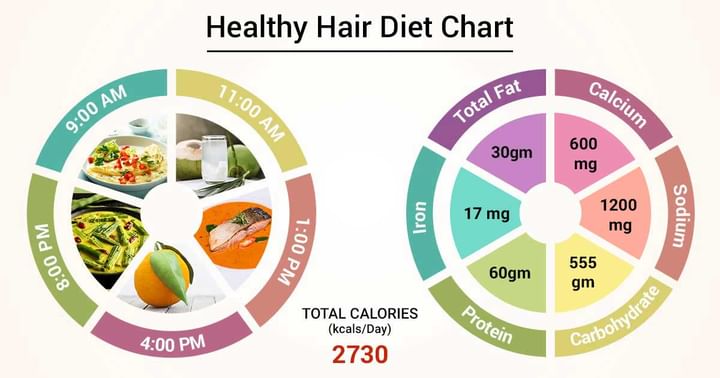Diet Chart For Healthy hair
Last Updated: Jan 20, 2025
About
Hair fall and baldness is increasingly becoming a problem for most people who love to eat junk food, follow an unhealthy eating pattern and have a stressed lifestyle. Hair fall can also be caused by anxiety, insomnia, hair abuse or excessive use of chemicals like bleaching treatments, perming and coloring. Soft drinks, snacks like fried, overcooked junk snacks, caffeine, alcohol and nicotine have detrimental effects on the nutrients that enhance hair growth. Stress, some medications and poor dietary habits are known to retard hair growth. Eating right, exercising, relieving stress and getting plenty of sleep will help you maximize your hair growth. Also, incorporating healthy foods in your day-to-day diet will lead to a healthy hair growth.
As hair is made of protein, ensuring you have enough protein in your diet is crucial for making hair strong and healthy. If you are not consuming enough protein in your diet, your hair is likely to become dry, brittle and weak. Extremely low protein diets may result in restricted hair growth and even hair loss. Choose chicken, turkey, fish, dairy products and eggs as excellent sources of protein along with vegetarian sources such as legumes and nuts. Eat the correct balance of the following nutrients including protein, vitamins and minerals to supply hair with all that it needs to remain shiny, lustrous and strong. Iron is an especially important mineral for hair and too little iron is a major cause of hair loss. The hair follicle and root are fed by a nutrient rich blood supply. When iron levels (serum ferritin) fall below a certain point, you may experience anaemia. This disrupts the nutrient supply to the follicle, affecting the hair growth cycle and may result in shedding. Animal products such as red meat, chicken and fish provide iron with a high bioavailability, meaning the iron is readily available to the body. Vegetarians can raise their iron stores by including lentils, spinach and other leafy green vegetables such as broccoli, kale and salad greens.
Diet Chart
| Sunday | |
| Breakfast (8:00-8:30AM) | 2 capsicum omelete + 1 multigrain bread toasted + 1 cup milk |
| Mid-Meal (11:00-11:30AM) | 1 cup coconut water |
| Lunch (2:00-2:30PM) | 50gms salmon fish curry + 1 cup beans vegetable + 2 multigran chapatti + beetroot salad |
| Evening (4:00-4:30PM) | 1 orange |
| Dinner (8:00-8:30PM) | 1 cup potato and drumstick curry + 2 chapatti + salad |
| Monday | |
| Breakfast (8:00-8:30AM) | 2 beetroot parantha + 1/2 cup curd |
| Mid-Meal (11:00-11:30AM) | 1 cup pomegranate |
| Lunch (2:00-2:30PM) | 1 cup potato carrot vegetable + 2 chapatti + 1 cup curd + salad |
| Evening (4:00-4:30PM) | 1 avocado |
| Dinner (8:00-8:30PM) | 1 cup palak paneer + 2 chapatti + salad |
| Tuesday | |
| Breakfast (8:00-8:30AM) | 1 cup vegetable rice flakes + 1 orange |
| Mid-Meal (11:00-11:30AM) | 1 cup guava |
| Lunch (2:00-2:30PM) | 1 cup lotus stem + 2 chapatti + 1/2 cup curd + salad |
| Evening (4:00-4:30PM) | 1 cup fish pakora + green chutney |
| Dinner (8:00-8:30PM) | 1 cup arhar dal + carrot salad + 2 chapatti |
| Wednesday | |
| Breakfast (8:00-8:30AM) | 2 onion capsicum omelette + 1 cup low fat milk |
| Mid-Meal (11:00-11:30AM) | 1 cup watermelon |
| Lunch (2:00-2:30PM) | 1 cup pumpkin vegetable + 2 chapatti + 1 cup collard beans salad |
| Evening (4:00-4:30PM) | 1 cup sprouts salad |
| Dinner (8:00-8:30PM) | 1 cup palak paneer + 2 chapatti + tomato salad |
| Thursday | |
| Breakfast (8:00-8:30AM) | 2 multigrain toasted bread + 1 spinach omelete + 1 gooseberry |
| Mid-Meal (11:00-11:30AM) | 1 cup aloe juice |
| Lunch (2:00-2:30PM) | 1 cup fish curry + 1 cup brown rice + beetroot salad |
| Evening (4:00-4:30PM) | 1 cup lemon water |
| Dinner (8:00-8:30PM) | 1 cup potato and capsicum + 2 chapatti + cucumber salad |
| Friday | |
| Breakfast (8:00-8:30AM) | 2 broccoli and egg omelette + 1 toasted wheat bread ith peanut butter |
| Mid-Meal (11:00-11:30AM) | 1 cup green tea + 1 tsp honey + 5-6 almonds |
| Lunch (2:00-2:30PM) | 1 cup baked kale with mushroom and tomato + 1 cup brown rice |
| Evening (4:00-4:30PM) | 1 cup brussel sprout salad |
| Dinner (8:00-8:30PM) | 1 cup cabbage peas + 2 chapatti + cucumber salad |
| Saturday | |
| Breakfast (8:00-8:30AM) | 1 cup quinoa salad + 1 cup orange juice |
| Mid-Meal (11:00-11:30AM) | 2 apricots |
| Lunch (2:00-2:30PM) | 1 cup sweet potato curry + 1 cup brown rice + carrot salad |
| Evening (4:00-4:30PM) | 1 cup musk melon |
| Dinner (8:00-8:30PM) | 1 cup fenugreek with pea vegetable + 2 chapatti + onion salad |
Do's And Dont's
Do's
- Do regular exercise
- Follow proper diet.
- Have a weekly scalp massage to provide stimulation to the hair follicles.
- Get plenty of rest and sleep to allow your body to grow hair.
Dont's
- Avoid unnecessary brushing, combing or handling. Use a soft, round bristles brush.
- Avoid hot shower.
- Smoking.
Food Items You Can Easily Consume
- cereals- fortified cereals and Wholegrains
- milk and milk products- skim milk, yogurt, cottage cheese
- meat- lean chicken, fish (salmon), eggs, oysters, beef
- fruits and vegetables- blackcurrants, blueberries, broccoli, guava, kiwi fruits, oranges, papaya, strawberries, avocado, orange/yellow coloured vegetables such as carrots, pumpkins, onions and sweet potatoes
- nuts and seeds- pumpkin seeds, chia seed, almonds and walnuts
- pulses and legumes- kidney beans, chickpeas, masoor dal, moongs beans
- oils- sunflower oil, avocado oil, soybean oil, cod liver oil
References
- Guo EL, Katta R. Diet and hair loss: effects of nutrient deficiency and supplement use. Dermatology practical & conceptual. 2017 Jan;7(1):1.
- O'Connell TC, Hedges RE. Investigations into the effect of diet on modern human hair isotopic values. American Journal of Physical Anthropology: The Official Publication of the American Association of Physical Anthropologists. 1999 Apr;108(4):409-25.
- Sinclair RD. Healthy hair: what is it?. InJournal of Investigative Dermatology Symposium Proceedings 2007 Dec 1 (Vol. 12, No. 2, pp. 2-5). Elsevier.
Table of content
Find Dietitian/Nutritionist near me
Ask a free question
Get FREE multiple opinions from Doctors



